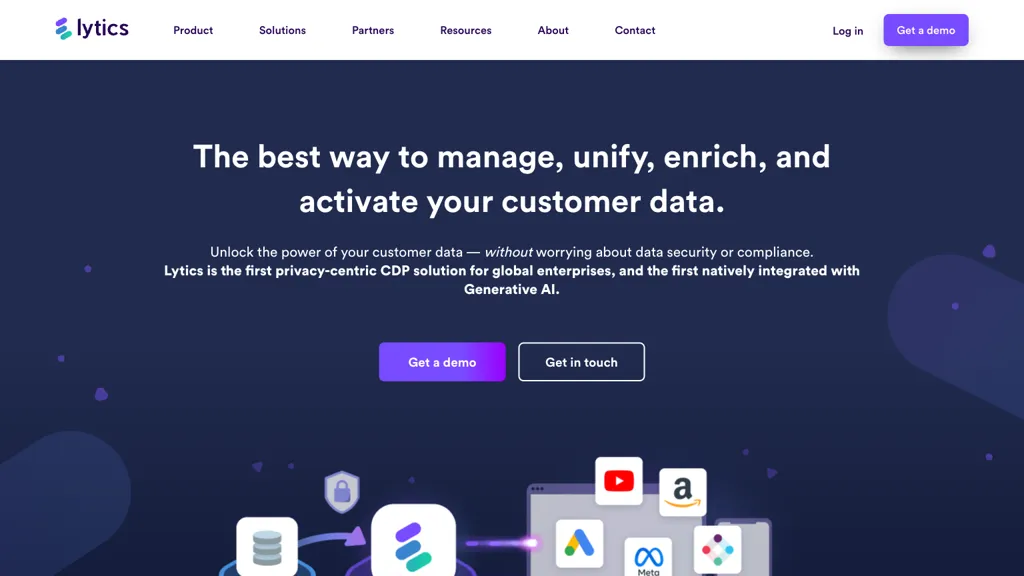What is Lytics?
The Lytics Customer Data Platform is a privacy-first, generative AI-enabled solution for global enterprises. It prides itself with a modular, flexible architecture, able to empower unified, enriched, and activated customer data for businesses without making any compromise on security and compliance. Offering peerless cloud data warehouse integrations and clean room functionalities, Lytics leads several companies’ preference lists, notably Google Cloud users.
Key Features & Benefits of Lytics
Lytics is powered by a range of features that place it among the most powerful customer data platforms available.
-
AI Generative Capabilities:
Utilize AI to streamline all operations with data and turbocharge decision-making. -
Three-Product Framework:
Conductor, Cloud Connect, and Decision Engine for a wide realm of data management needs. -
Identity Resolution:
Deliver the best user profiles through the resolution of disparate data points. -
Behavior Scoring:
Get to know your customers in terms of their behaviors to better their engagement strategies.
Create Transformational Audience Segments: Enterprise can effortlessly create cutting-edge audience segments with AI-driven prompts. In turn, Lytics can allow enterprise to have a single view of the customer, drive more effective personalized marketing campaigns, and make data-driven decisions faster.
Lytics Use Cases and Applications
Lytics CDP is pretty versatile for a wide range of use cases.
-
Audience Generation:
An AI-powered audience generator that empowers marketers to create hyper-targeted, personalized audience segments to ensure efficient marketing. -
Data Mapping and Unification:
The Schema Copilot can map and unify effectively customer data to provide a 360-degree view of customer interaction and preference. -
Customer 360 Readiness:
The Customer 360 Readiness Index is a tool by which companies can assess and optimize their CDP strategy to ensure that everything is in place for deep insight into who their customers are, which is crucial for driving business growth.
It helps retail, finance, or agencies offering digital marketing solutions build unparalleled experiences with their customers and come up with robust internal processes. How does one get on with Lytics? Well, first things first, the following few steps will get you started with Lytics:
-
Setup:
Integrating Lytics into the greater ecosystem of your data sources and platforms. -
Data Mapping:
Schema Copilot will help in data mapping and the unification of your customer data into one single unified view. -
Creating Audiences:
Leveraging the AI-powered Audience Generator, create hyper-targeted segments of audiences. -
Behavioral Scoring:
Allow behavioral scoring to be applied in understanding and predicting customers’ actions. -
Optimization:
Run the Customer 360 Readiness Index tool quite frequently in order to check, explore, and optimize your CDP strategy for the betterment.
Remember, your data should be clean and must always be in update mode. Know the user interface well to have easy access and operate the different features with ease.
How Lytics Works
Lytics makes advanced AI technologies and cloud integrations the backbone of its core functions through the following steps:
-
Data Collection:
All-inclusive data from more diversified sources than any other CDP-ranging from CRM systems, web analytics, and social media platforms. -
Data Unification:
Schema Copilot is used for mapping and unifying data into one golden customer view. -
AI & Machine Learning:
Generative AI leverages the analysis of data, surfaces insights, and creates discrete audience segments. -
Activation:
It makes it easy for a business to take this rich customer profile and uses it across a number of marketing channels for a highly targeted campaign.
It’s a frictionless workflow that enables businesses to manage and leverage their customer data proficiently, drive smarter marketing decisions, and help in creating better customer experiences.
Lytics Pros and Cons
Like any other platform, Lytics has its strong and weak points, and in those senses, here are the pros and cons:
Pros:
- Advanced AI functionalities for seamless data operations.
- Strong features for integration and unification of data.
- Stronger audience segmentation and behavioral insight.
- User-friendly interface; fantastic support tools.
Cons:
- It does take some getting used to in case a user is less acquainted with operating AI-driven platforms.
- Advanced features and more installations can be costly.
On the whole, user reviews have great things to share about the tool and pinpoint the dramatic changes it can bring to how one can manage data and marketing efforts.
Conclusion for Lytics
Lytics Customer Data Platform is the best option available for enterprises that strive to improve the management of data and activities related to marketing. With best-in-class AI and scalable architecture, Lytics enables your business to connect and activate customer data securely and efficiently. Due to substantial and continuous development on this platform, it is bound to bring forth more inventive elements that will help meet the growing demand for data-driven marketing.
Lytics FAQs
What kind of businesses may Lytics assist?
Essentially, it is any business that needs customer data to drive marketing and engagement, hence reaching out to retail, finance, and digital marketing agencies.
How easy is it to integrate Lytics with existing systems?
Lytics has strong integrations with most data sources and platforms, providing seamless integration with systems you have running.
Security and compliance ensured by Lytics:
Lytics has been designed in a way to enforce a privacy-centric approach, ensuring each form of data management is compliant with all set standards and global regulations.










